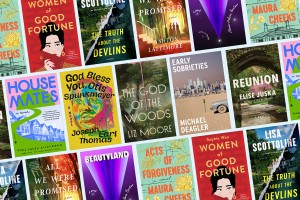A Different Drummer
The angel on his shoulder quiets the pope jokes swirling in his head, and Ahmir arrives for soundcheck with the most impressive combo he’ll team with tonight. To his left, Grateful Dead’s Phil Lesh straps on his bass. To his right is young singer/guitarist John Mayer, who recruited Ahmir for his last platinum-selling record. And at the microphone is none other than Rock ’n’ Roll Hall of Famer Buddy Guy, a bona fide blues deity. They launch into “Hoochie Coochie Man,” and Ahmir drives his redwood-thick right leg into the bass pedal. He’s a human metronome with subtle flourishes, never flashy, always playing in service of the song and not his own spotlight.
The foursome runs through the final bars until Guy mutes his guitar and turns to the drummer. Ahmir has toured from Paris to Osaka. He’s played for crowds of 110,000, and on a quiet block near Graduate Hospital, a Grammy holds down magazines on top of his toilet. But when Guy looks at him, there’s a hint of sweat on Ahmir’s forehead.
“That’s all I want,” Guy says. The legend smiles, as if to say, Everything’s gonna be all right tonight, son. You’ve got it down cold.
Two hours later, it’s showtime, and you’d think this supergroup had practiced for weeks. Ahmir even secures his slipping Afro pick mid-song, with his snare hand no less, without disrupting the beat. The packed house applauds from its feet. Soon midnight arrives, and the stage fills for an epic encore. As Bob Marley’s “Lively Up Yourself” gives way to “Crosstown Traffic,” you can practically feel Ahmir’s mental jukebox overheating. Oddly enough, the first person to congratulate him afterward is O’Connor.
“My friends say I’m dumb for not listening to modern hip-hop,” she tells him. When he replies, “I’ll send you some Roots records,” there’s sympathy in his voice.
The bespectacled beast inside him stirs as the curtain falls on the Jammys. It’s moments like these that have driven him to become, in the words of Larry Gold, Grammy-winning arranger and member of Gamble & Huff’s legendary house band, “the most famous Philly musician, and rightfully so. He is the best drummer of his generation.” It’s also the reason why, for all his acclaim, he’ll never be half as famous, or as rich, as 50 Cent.
“Yo, all I’m saying is that Bono had some balls to roll up on Graceland and sit on Elvis’s bike.”
Less than a week after the Jammys, the Roots are among the headliners on the final night of the Beale Street Music Festival, Tennessee’s three-day answer to Mardi Gras. Ahmir just finished a tour of the Elvis estate in Memphis, and is now arguing with his assistant, Dawn Englehart, and Roots guitarist “Captain” Kirk Douglas over how U2 managed to film its 1988 documentary Rattle & Hum here, where flash photography is vehemently prohibited, and precisely what level of pop-culture knighthood Bono had achieved at that point. Kirk says Bono was already a cross-cultural icon. Ahmir, wearing a bright red Heinz Ketchup tee and massive glasses bearing Elvis’s motto — TCB, Taking Care of Business — picks out his hair helmet and disagrees: “People in the ghetto didn’t know him until he was hanging with Mandela!”


